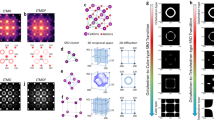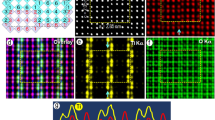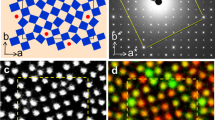Abstract
The intercalation of alkali ions into layered materials has played an essential role in battery technology since the development of the first lithium-ion electrodes. Coulomb repulsion between the intercalants leads to ordering of the intercalant sublattice, which hinders ionic diffusion and impacts battery performance. While conventional diffraction can identify the long-range order that can occur at discrete intercalant concentrations during the charging cycle, it cannot determine short-range order at other concentrations that also disrupt ionic mobility. In this Article, we show that the use of real-space transforms of single-crystal diffuse scattering, measured with high-energy synchrotron X-rays, allows a model-independent measurement of the temperature dependence of the length scale of ionic correlations along each of the crystallographic axes in sodium-intercalated V2O5. The techniques described here provide a new way of probing the evolution of structural ordering in crystalline materials.
This is a preview of subscription content, access via your institution
Access options
Access Nature and 54 other Nature Portfolio journals
Get Nature+, our best-value online-access subscription
$29.99 / 30 days
cancel any time
Subscribe to this journal
Receive 12 print issues and online access
$259.00 per year
only $21.58 per issue
Buy this article
- Purchase on Springer Link
- Instant access to full article PDF
Prices may be subject to local taxes which are calculated during checkout





Similar content being viewed by others
Data availability
Files containing the datasets used in this Article are available for download from the Materials Data Facility43 (https://doi.org/10.18126/ooin-ce23) as NeXus files stored in the HDF5 format44. The files for each measured temperature contain S(Q), ΔPDF and, at three temperatures, the total PDF results. The data can be plotted using the Python package NeXpy (http://nexpy.github.io/nexpy/).
References
Whittingham, M. S. Electrical energy storage and intercalation chemistry. Science 192, 1126–1127 (1976).
Winter, M., Barnett, B. & Xu, K. Before Li ion batteries. Chem. Rev. 118, 11433–11456 (2018).
Whittingham, M. S. Ultimate limits to intercalation reactions for lithium batteries. Chem. Rev. 114, 11414–11443 (2014).
Tepavcevic, S. et al. Nanostructured layered cathode for rechargeable Mg-ion batteries. ACS Nano 9, 8194–8205 (2015).
Sai Gautam, G. et al. The intercalation phase diagram of Mg in V2O5 from first-principles. Chem. Mater. 27, 3733–3742 (2015).
Sun, X., Bonnick, P. & Nazar, L. F. Layered TiS2 positive electrode for Mg batteries. ACS Energy Lett. 1, 297–301 (2016).
Mizushima, K., Jones, P. C., Wiseman, P. J. & Goodenough, J. B. LixCoO2 (0 < x ≤ 1): a new cathode material for batteries of high energy density. Mater. Res. Bull. 15, 783–789 (1980).
Goodenough, J. B. & Kim, Y. Challenges for rechargeable Li batteries. Chem. Mater. 22, 587–603 (2010).
Berlinsky, A. J., Unruh, W. G., McKinnon, W. R. & Haering, R. R. Theory of lithium ordering in LixTiS2. Solid State Commun. 31, 135–138 (1979).
Thompson, A. H. Lithium ordering in LixTiS2. Phys. Rev. Lett. 40, 1511–1514 (1978).
Reynier, Y. et al. Entropy of Li intercalation in LixCoO2. Phys. Rev. B 70, 174304 (2004).
Reimers, J. N. & Dahn, J. R. Electrochemical and in situ x-ray diffraction studies of lithium intercalation in LixCoO2. J. Electrochem. Soc. 139, 2091–2097 (1992).
Li, W., Reimers, J. N. & Dahn, J. R. Crystal structure of LixNi2−xO2 and a lattice-gas model for the order–disorder transition. Phys. Rev. B 46, 3236–3246 (1992).
Gao, Y., Reimers, J. N. & Dahn, J. R. Changes in the voltage profile of Li/Li1+xMn2O4 cells as a function of x. Phys. Rev. B 54, 3878–3883 (1996).
Kim, S. W. & Pyun, S. I. Thermodynamic and kinetic approaches to lithium intercalation into a Li1−δMn2O4 electrode using Monte Carlo simulation. Electrochim. Acta 46, 987–997 (2001).
Wolverton, C. & Zunger, A. First-principles prediction of vacancy order–disorder and intercalation battery voltages in LixCoO2. Phys. Rev. Lett. 81, 606–609 (1998).
Van der Ven, A., Aydinol, M. K., Ceder, G., Kresse, G. & Hafner, J. First-principles investigation of phase stability in LixCoO2. Phys. Rev. B 58, 2975–2987 (1998).
Ceder, G. & Van der Ven, A. Phase diagrams of lithium transition metal oxides: investigations from first principles. Electrochim. Acta 45, 131–150 (1999).
Wang, P.-F. et al. Na+/vacancy disordering promises high-rate Na-ion batteries. Sci. Adv. 4, eaar6018 (2018).
Toumar, A. J., Ong, S. P., Richards, W. D., Dacek, S. & Ceder, G. Vacancy ordering in O3-type layered metal oxide sodium-ion battery cathodes. Phys. Rev. Appl. 4, 064002 (2015).
Chen, T., Sai Gautam, G., Huang, W. & Ceder, G. First-principles study of the voltage profile and mobility of Mg intercalation in a chromium oxide spinel. Chem. Mater. 30, 153–162 (2017).
Kaufman, J. L. & Van der Ven, A. NaxCoO2 phase stability and hierarchical orderings in the O3/P3 structure family. Phys. Rev. Mater. 3, 015402 (2019).
Shao-Horn, Y., Levasseur, S., Weill, F. & Delmas, C. Probing lithium and vacancy ordering in O3 layered LixCoO2 (x ≈ 0.5). J. Electrochem. Soc. 150, A366–A373 (2003).
Welberry, T. R. & Butler, B. D. Diffuse X-ray scattering from disordered crystals. Chem. Rev. 95, 2369–2403 (1995).
Frey, F. Diffuse scattering from disordered crystals. Acta Crystallogr. B 51, 592–603 (1995).
Nield, V. M. & Keen, D. A. Diffuse Nneutron Sscattering from Ccrystalline Mmaterials (Oxford Univ. Press, 2001).
Egami, T. & Billinge, S. J. L. (eds) Underneath the Bragg Peaks, Structural Analysis of Complex Materials (Pergamon, 2003).
Weber, T. & Simonov, A. The three-dimensional pair distribution function analysis of disordered single crystals: basic concepts. Z. Kristallogr. 227, 238–247 (2012).
Wadsley, A. D. The crystal structure of Na2−xV6O15. Acta Crystallogr. 8, 695–701 (1955).
Kanai, Y., Kagoshima, S. & Nagasawa, H. Structural phase transition in β-MxV2O5 (M = Na, Li). J. Phys. Soc. Jpn. 51, 697–698 (1982).
Marley, P. M., Horrocks, G. A., Pelcher, K. E. & Banerjee, S. Transformers: the changing phases of low-dimensional vanadium oxide bronzes. Chem. Commun. 51, 5181–5198 (2015).
Hughes, J. M. & Finger, L. W. Bannermanite, a new sodium-potassium vanadate isostructural with β-NaxV6O15. Am. Miner. 68, 634–641 (1983).
Hiroyuki, Y. & Yutaka, U. Magnetic, electric and structural properties of β-AxV2O5 (A = Na, Ag). J. Phys. Soc. Jpn. 68, 2735–2740 (2013).
Marley, P. M. et al. Emptying and filling a tunnel bronze. Chem. Sci. 6, 1712–1718 (2015).
Horrocks, G. A. et al. Mitigating cation diffusion limitations and intercalation-induced framework transitions in a 1D tunnel-structured polymorph of V2O5. Chem. Mater. 29, 10386–10397 (2017).
Galy, J., Darriet, J., Casalot, A. & Goodenough, J. B. Structure of the MxV2O5-β and MxV2−yTyO5-β phases. J. Solid State Chem. 1, 339–348 (1970).
Yamaura, J.-i, Isobe, M., Yamada, H., Yamauchi, T. & Ueda, Y. Low temperature X-ray study of β-AxV2O5. J. Phys. Chem. Solids 63, 957–960 (2002).
Yamada, H. & Ueda, Y. Magnetic, electric and structural properties of β-AxV2O5 (A = Na, Ag). J. Phys. Soc. Jpn. 68, 2735–2740 (1999).
Collins, M. F. Magnetic Critical Scattering (Oxford Univ. Press, 1989).
Meethong, N., Kao, Y. H., Speakman, S. A. & Chiang, Y.-M. Aliovalent substitutions in olivine lithium iron phosphate and impact on structure and properties. Adv. Funct. Mater. 19, 1060–1070 (2009).
Jovanović, A. et al. Structural and electronic properties of V2O5 and their tuning by doping with 3d elements—modelling using the DFT+U method and dispersion correction. Phys. Chem. Chem. Phys. 20, 13934–13943 (2018).
Jennings, G. Crystal Coordinate Transformation Workflow (CCTW) (SourceForge, 2019); https://sourceforge.net/projects/cctw/
Blaiszik, B. et al. The Materials Data Facility. J. Miner. Met. Mater. Soc. 68, 2045–2052 (2016).
Könnecke, M. et al. The NeXus data format. J. Appl. Crystallogr. 48, 301–305 (2015).
Acknowledgements
This work was supported by the US Department of Energy, Office of Science, Office of Basic Energy Sciences, Materials Sciences and Engineering Division and Scientific User Facilities Division. X-ray experiments were performed at APS, which is supported by the Office of Basic Energy Sciences under contract no. DE-AC02-06CH11357, and CHESS, which is supported by the NSF and NIH/NIGMS via NSF award DMR-1332208. Computational developments were supported by the Exascale Computing Project (17-SC-20-SC), a collaborative effort of the US Department of Energy, Office of Science, and the National Nuclear Security Administration. We thank D. Robinson and X. Zhang for technical support during the experiments, A. Rettie for performing the EDX analysis, T. Weber and A. Simonov for discussions about the ΔPDF technique, B. Campbell for help with the formalism of transforming the data to reciprocal space and P. Zapol and C. Haley for discussions about interpreting the results. Crystal structure images were generated using CrystalMaker, CrystalMaker Software Ltd, http://www.crystalmaker.com.
Author information
Authors and Affiliations
Contributions
Samples were prepared by J.T.V. and prepared for measurement by M.J.K. The experiments were devised by M.J.K., S.R. and R.O. The X-ray experiments were performed by M.J.K., S.R., J.P.C.R., J.M.W. and R.O. The data were analysed by M.J.K., R.O., J.M.W. and G.J., using software written by G.J., M.J.K., R.O. and J.M.W. The manuscript and Supplementary information were written by R.O. with input from all the authors.
Corresponding author
Ethics declarations
Competing interests
The authors declare no competing interests.
Additional information
Publisher’s note Springer Nature remains neutral with regard to jurisdictional claims in published maps and institutional affiliations.
Supplementary information
Supplementary Information
Supplementary methods, Figs. 1–15, notes and references.
Rights and permissions
About this article
Cite this article
Krogstad, M.J., Rosenkranz, S., Wozniak, J.M. et al. Reciprocal space imaging of ionic correlations in intercalation compounds. Nat. Mater. 19, 63–68 (2020). https://doi.org/10.1038/s41563-019-0500-7
Received:
Accepted:
Published:
Issue Date:
DOI: https://doi.org/10.1038/s41563-019-0500-7
This article is cited by
-
Bragg glass signatures in PdxErTe3 with X-ray diffraction temperature clustering
Nature Physics (2024)
-
Effect of pre-intercalation on Li-ion diffusion mapped by topochemical single-crystal transformation and operando investigation
Nature Materials (2024)
-
Local inversion-symmetry breaking in a bismuthate high-Tc superconductor
Nature Communications (2023)
-
Quantitative three-dimensional local order analysis of nanomaterials through electron diffraction
Nature Communications (2023)
-
Unconventional short-range structural fluctuations in cuprate superconductors
Scientific Reports (2022)



